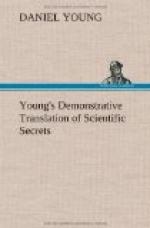Take 4 parts of brass, and 4 parts of tin; when fused add 4 parts of metallic bismuth, and 4 parts of metallic antimony. This composition is added at discretion to metallic tin, according to the quality you wish to make.
152. Blanched copper
Melt together 8 parts of copper and a half part of arsenic.
153. Common pewter
Melt together 4 parts of tin and 1 part of lead.
154. Best pewter
Melt together 100 parts of tin and 17 of antimony.
155. A metal that expands in cooling
Melt together 9 parts of lead, 2 of antimony and one of bismuth. This metal is very useful in filling small defects in iron castings, &c.
156. Queen’s metal
Melt together 9 parts of tin, 1 of antimony, 1 of bismuth, and 1 of lead.
157. Imitation platinum
This metal, or alloy, very closely resembles platinum. Melt together 8 parts of brass and 5 parts of zinc.
158. Chinese white copper
Melt together 40.4 parts of copper, 31.6 parts of nickel, 25.4 of zinc, and 2.6 of iron.
159. Manheim gold
Melt together 3 parts copper, 1 of zinc, and a little tin.
160. TOMBACK, or red brass
Melt together 8 parts of copper, and 1 part of zinc.
161. Imitation gold
Take of platina 8 parts, of silver 4 parts, copper 12 parts, melt all together.
162. Imitation silver
Take of block tin 100 parts, metallic antimony 8 parts, bismuth 1 part, and 4 parts of copper; melt all together.
163. True imitation of gold
Dr. Harmsteadt’s imitation of gold, which is stated not only to resemble gold in colour, but also in specific gravity and ductility, consists of 16 parts of platinum, 7 parts of copper, and 1 of zinc, put in a crucible, covered with charcoal powder, and melted into a mass.
164. True imitation of silver
Imitation of pure silver, so perfect in its resemblance that no chemist living can tell it from pure virgin silver. It was obtained from a German chemist now dead; he used it for unlawful purposes to the amount of thousands, and yet the metal is so perfect that he was never discovered. It is all melted together in a crucible, here it is: 1/4 oz. of copper, 2 oz. of brass, 3 oz. of pure silver, 1 oz. of bismuth, 2 ozs. of saltpetre, 2 ozs. of common salt, 1 oz. of arsenic, and 1 oz. of potash.
165. Moulds and Dies
Take copper, zinc, and silver, in equal proportions, and melt them together, and mould into the forms you desire, and bring the same to a nearly white heat; now lay on the thing that you would take the impression of, and press it with sufficient force, and you will find that you have a perfect and beautiful impression. All of the above metals should be melted under a coat of powdered charcoal.




